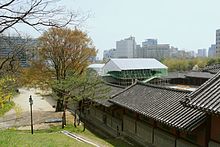Gyeonghuigung
| Korean spelling | |
|---|---|
| Korean alphabet : | 경희궁 |
| Hanja : | 慶 熙 宮 |
| Revised Romanization : | Gyeonghuigung |
| McCune-Reischauer : | Kyŏnghŭng |
Gyeonghuigung [kjəŋhɨkuŋ] is a palace under five palaces in Seoul , during the reign of the Joseon Dynasty were built.
history
The palace was built between 1617 and 1623 under the original name Gyeongdeokgung by the 15th King Gwanghaegun (1608–1623). In 1760 the palace was renamed Gyeonghuigung by King Yeongjo . Its name means "palace of undisturbed harmony" in Korean. It was also called the Western Palace (Seogwol) because it was in the west of the city.
Large parts of the palace burned down in 1829, but were rebuilt in the following years. At times the palace was so large that it was connected to Deoksugung by a bridge under King Gojong in 1905 .
During the Japanese rule in the previous century, many buildings were destroyed or relocated and the Japanese Gyeongreong Middle School was built in its place.
In 1980 the historical site of Gyeonghuigung was added to the Korean "Historic Site" list under number 271. In the 1990s, the South Korean government started a program to reconstruct the five great palaces. It was only possible to reconstruct about a third of the Gyeonghuigung. From 2002 the palace was open to the public again.
building
- Sungjeongjeon
- Jajeongjeon
- Taeryeongjeon
- Heunghwamun
- Geumcheongyo Bridge
swell
- Peter Messingfeld: Adventure Seoul. A culture and travel guide . Verlag Lydia Messingfeld, 2009. ISBN 978-3-00-028593-6
- Leaflet Gyeonghuigung Palace (English). Published by the Seoul Museum of History, 2011
Remarks
- ↑ The other four are Gyeongbokgung , Changdeokgung , Changgyeonggung , Deoksugung
Coordinates: 37 ° 34 '17.2 " N , 126 ° 58' 5.3" E


